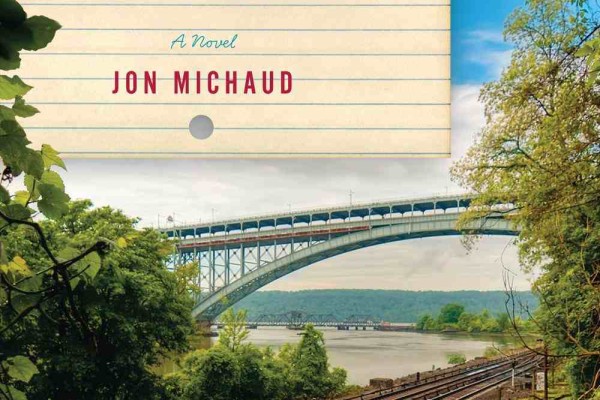“When Tito Loved Clara” 338 pages. Algonquin Books of Chapel Hill. $23.95.
I never imagined I would write much of my first published book in half-hour bursts on a commuter train
The characters of When Tito Loved Clara have been described as “rich emotional studies” by The New Yorker, (where Michaud works), and certainly Michaud assigns his lovers deep and complex histories. Clara has escaped her old neighborhood of Inwood, running away from her cruel, abusive family. Leaving behind her Dominican past she now lives behind a picket fence in New Jersey with a white husband, son, and steady job.
Clara’s childhood boyfriend Tito, (with whom she enjoyed clandestine assignations in Inwood Hill Park), still dreams of the life he could have had with his first love. The adult Tito and Clara collide, and Tito’s youthful fantasy is forced to bow to a changed reality. The book cleverly evokes the way we cling to that first experience of love. We clutch its memory to our chests far into our adult lives, refusing to examine the truth behind the dreams.
EXTRACT
“[Clara] occupied more and more of Tito’s mind and took on a significant role in his fantasy life. Between classes he looked for her, and when she did appear from the throngs in the halls, he trailed behind her, floating in the wake of her smell—of gardenias and candy—like a cartoon character following the scent of a freshly baked pie. Sometimes he would trail her all the way to the other side of the school, far from his next class. The bell would ring and he would come to himself alone in the hallway, late again.”
How did you keep yourself motivated to keep writing whilst working on When Tito Loved Clara?
Simple: desperation. I had been writing fiction for more than twenty years and I had little to show for it, aside from a handful of stories in literary quarterlies, and drawers full of unpublished manuscripts. Entering my forties, with a wife and two children and a mortgage and a full time job, I had the clear sense that it was now or never. A book of stories that I’d written about Inwood in the late nineties and early 2000s had aroused the interest of an agent, who’d unsuccessfully submitted it to New York publishers. There were some encouraging rejections, however, including several that asked for a novel.
Eager to meet this demand, I took two stories from the collection and developed them into the novel that now bears the title “When Loved Clara.” If there’s one lesson that I learned from the long process of working toward publication, it’s that desire matters much more than talent. I never imagined that it would take so long, or that I would write much of my first published book in half-hour bursts on a commuter train, but that’s indeed what happened.
Did you have a regular reader/readers whilst writing When Tito Loved Clara, to give you feedback? How did this assist, or impede your writing process?
Good early readers—that is readers who are honest, insightful, and unafraid to tell the truth—can save a writer months of work. I have a small group of friends who see my work before I send it to my agent. One of them, a poet and playwright I’ve known since college, made a crucial comment after reading my first draft, which substantially changed the final chapters of the book for the better. His remarks were informed by his grounding in dramatic structure, and illuminated a problem I had not been willing to confront. It’s important to be self-confident enough to ignore useless and vapid comments about your writing, but also to be open-minded enough to accept sound criticism and act on it.
Did you make any major plot changes whilst writing the novel; for example changing the ending? How did you know when to stop tinkering with the story?
Aside from the instance mentioned above, there were several fairly significant changes made during the editing process once the book was purchased by Algonquin. There are a lot of flashbacks and several key revelations in the novel and the orchestration and pacing of those elements needed a lot of attention. My editor, Jane Rosenman, is a veteran and her instincts regarding plot twists and the doling out of crucial information proved to be unerring. In my unedited draft, I was giving too much away too soon. We also added several dozen pages of background material and fleshed out scenes to set up the twists that occur later in the book. The lament that editors don’t edit anymore is certainly not true in the case of Algonquin. A skilled editor can transform a manuscript and establishing a good editorial relationship with Jane was crucial to the book’s success. I knew to stop tinkering when she told me to stop.
How did your M.A in Creative Writing from Lancaster University develop your writing skills? What would your advice be to writers in M.F.A programs to make the most out of this time?
The Lancaster M.A. was unlike most American M.F.A. programs in that we had no coursework. The seven writers in the program were expected to do only two things: to write, and to read and comment on each other’s work. We met twice a week for three hours and the rest of the time we were expected to be getting on with the business of writing and reading. It was the first (and so far only) year in my life that was devoted exclusively to writing fiction and I did not waste the opportunity. I came away from Lancaster with a book of short stories, half of a novel, and the beginnings of several lifelong friendships.
The course at Lancaster was a great boon for me as a writer. It gave me total responsibility for structuring my own workday and selecting my own reading lists. What it did not do—and this is clearly a focus for many M.F.A. programs in the U.S.—was prepare me to teach creative writing; it merely gave me time to write and access to a circle of receptive, intelligent readers. Nor did it put me in contact with agents and editors. In retrospect, that was probably a good thing, since I seem to be a late bloomer and my work needed many years to merit attention from agents and editors. This is perhaps the most difficult thing for a young writer to accept—that there is no timetable for publication. Each writer advances at his or her own pace and the successes and failures of your peers have no bearing on your own development.
There are some great female characters in When Tito Loved Clara, for example Clara and Deysi. Was it easy to get inside these characters heads?
“When Tito Loved Clara” is an autobiographical novel and some—though certainly not all—of the characters are inspired by real people. In many cases, I turned up the volume on those characters, changing details about them as the story required, accentuating traits in order to make them more dramatic. But beyond that familiarity, I must say thatI feel at home writing about both sexes and also writing about people from other ethnic backgrounds. Some credit for this should definitely go to the strong women in my life—especially my mother and my wife. I traveled a lot in my childhood, and lived in Iran, India, Northern Ireland, and France, which may also have contributed. It’s fiction after all, and if you write only about people like yourself, you are limiting yourself. I think novelists should be fearless when it comes to experimenting with writing outside their comfort zone. Sometimes it doesn’t work; other times the results can be electrifying. You won’t know until you try.
Can you give us a list of a few novels that have really shaped your identity as a writer, and helped you develop your style?
A random grab-bag from my stream of consciousness:
Books that shaped me: “Great Expectations” by Charles Dickens; “Watt” by Samuel Beckett; “Miss Lonelyhearts” by Nathaniel West; “Lost in the City” and “The Known World” by Edward P. Jones; “The Book of the New Sun” by Gene Wolfe; the Gormenghast trilogy by Mervyn Peake; “The Transit of Venus” by Shirley Hazzard; “The Sun Also Rises” by Ernest Hemingway; “Hunting Mister Heartbreak” by Jonathan Raban; the Letters of Shelby Foote and Walker Percy; Alice Munro’s short stories; plus the works of Don DeLillo.
Books that were important to the writing of this novel: “The Age of Innocence” by Edith Wharton; “The Lay of the Land” by Richard Ford; “Drama City” by George Pelecanos; “On Beauty” by Zadie Smith; “Little Children” by Tom Perotta; “The Good Life” by Jay McInerney; and “Drown” by Junot Diaz




